
Nassella pulchra, basionym Stipa pulchra, is a species of grass known by the common names purple needlegrass and purple tussockgrass. It is native to the U.S. state of California, where it occurs throughout the coastal hills, valleys, and mountain ranges, as well as the Sacramento Valley and parts of the Sierra Nevada foothills, and Baja California.

Danthonia californica is a species of grass known by the common name California oatgrass. This plant is native to two separate regions of the Americas, western North America from California to Saskatchewan, and Chile.
Elymus californicus is a species of wild rye known by the common name California bottlebrush grass. This grass is endemic to California where it is an uncommon species known from a few counties in the San Francisco Bay Area. It grows between one and two meters in height. The tall, erect stem is nearly naked, bearing the occasional sheathing leaf with a blade 10 to 20 centimeters long. It bears an erect inflorescence which curves as it becomes heavier in grain. Each inflorescence is divided into three or four nodes with three or four spikelets per node. Each spikelet is between one and two centimeters long, not counting a long awn about two centimeters long.

Elymus canadensis, synonyms including Elymus wiegandii, commonly known as Canada wild rye or Canadian wildrye, is a species of wild rye native to much of North America. It is most abundant in the central plains and Great Plains. It grows in a number of ecosystems, including woodlands, savannas, dunes, and prairies, sometimes in areas that have been disturbed.

Elymus elymoides is a species of wild rye known by the common name squirreltail. This grass is native to most of North America west of the Mississippi River and occurs in a number of ecosystems, from the alpine zone to desert sage scrub to valley grassland.

Festuca idahoensis is a species of grass known by the common names Idaho fescue and blue bunchgrass. It is native to western North America, where it is widespread and common. It can be found in many ecosystems, from shady forests to open plains grasslands.

Glyceria leptostachya is a species of mannagrass known by the common names davy mannagrass and narrow mannagrass.

Eriocoma parishii is a species of grass known by the common name Parish's needlegrass.
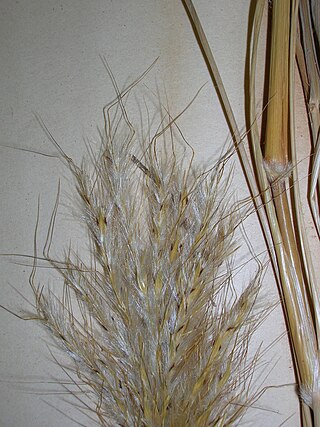
Bothriochloa barbinodis is a species of grass known by the common name cane bluestem. It is native to the Americas, including most of South and Central America, Mexico, and the southernmost continental United States from California to Florida.

Elymus multisetus is a species of wild rye known by the common name big squirreltail.

Elymus scribneri is a species of wild rye known by the common names spreading wheatgrass and Scribner's wheatgrass. It is native to much of the western United States and parts of central Canada where it grows in several types of habitat including alpine mountain peaks.

Elymus sierrae is a species of wild rye known by the common name Sierra wild rye. It is endemic to the High Sierra Nevada in California and far western Nevada, where it grows in coniferous forest and other mountain habitat generally above 2,200 metres (7,200 ft) in elevation.
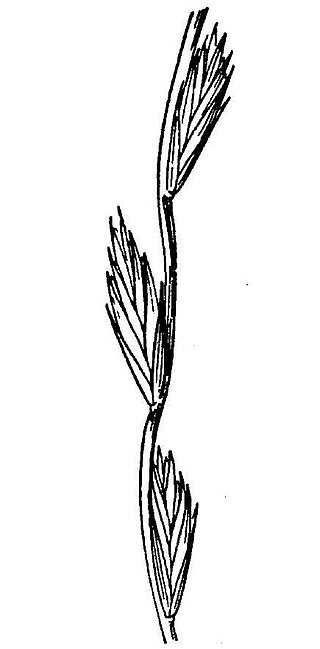
Elymus stebbinsii is a species of wild rye known by the common name Parish wheatgrass. It is endemic to California, where it grows in the forests and chaparral of many of the coastal and inland mountain ranges. It is a perennial grass growing up to 1.2 meters tall. The inflorescence is a narrow, linear series of single-spikelet nodes up to 25 centimeters long. Each spikelet is up to 2 centimeters long with a short awn of just a few millimeters.
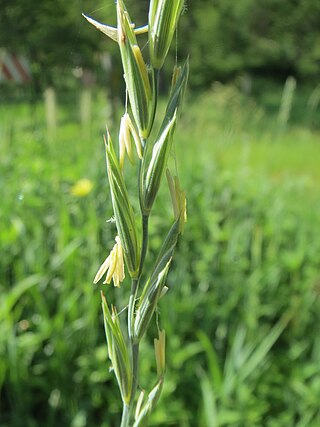
Elymus trachycaulus is a species of wild rye known by the common name slender wheatgrass. It is native to much of North America. It grows in widely varied habitats from northern Canada to Mexico, but is absent from most of the southeastern United States.

Leymus cinereus is a species of wild rye known by the common names basin wild rye, Great Basin wild rye, and Great Basin lyme grass.

Leymus triticoides, with the common names creeping wild rye and beardless wild rye, is a species of wild rye. It is native to western North America from British Columbia to California and Texas.

Muhlenbergia richardsonis, known by the common name mat muhly, is a species of grass. It is native to North America, where it can be found throughout much of Canada, Alaska, the western half of the contiguous United States through California, and in Baja California, Mexico.
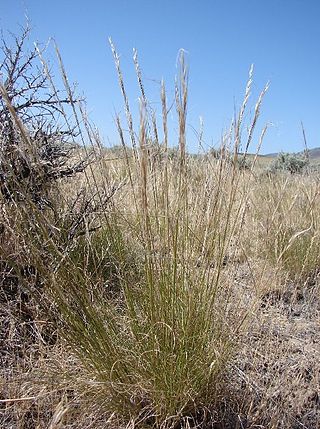
Eriocoma thurberiana is a species of grass known by the common name Thurber's needlegrass. It is native to the western United States, where it occurs from Washington to California and east to Montana and Wyoming.
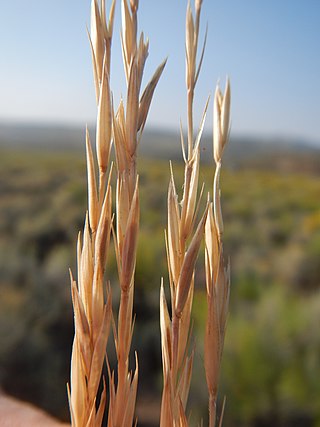
Leymus salina is a species of grass known as Salina wildrye, Salina Pass wild rye, and saline wildrye. It is native to the western United States and is named for its type locality: Salina Pass, Utah.
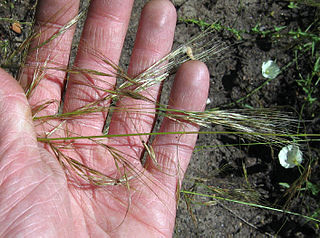
Nassella lepida is a species of grass known by the common names foothill needlegrass, foothills nassella, foothill stipa, small-flowered stipa, small-flowered needlegrass, and smallflower tussockgrass.



















